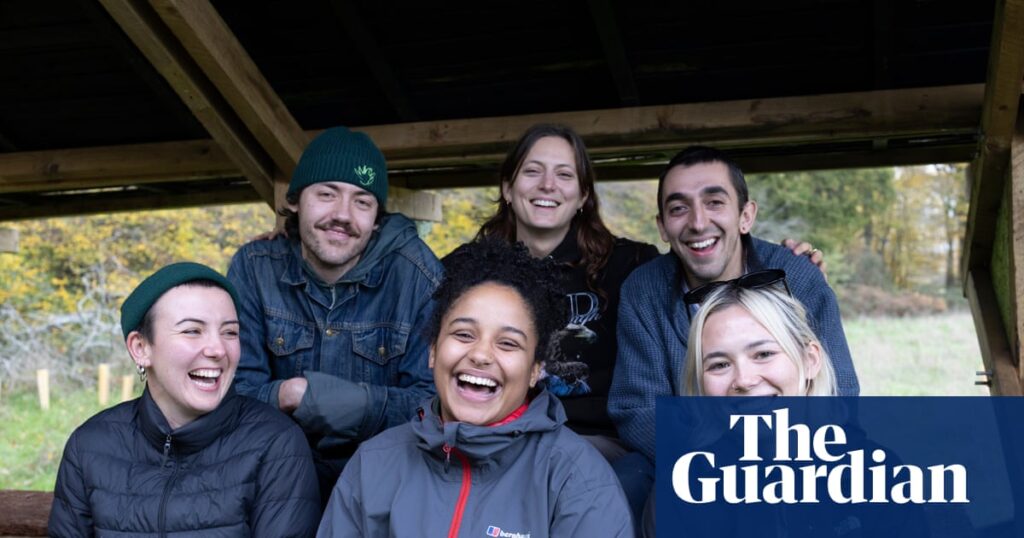
The manically melodic song of the nightingale is a rare sound in Britain these days, but not at Maple Farm. Four years ago, a single bird could be heard at this secluded spot in rural Surrey; this summer, they were everywhere. “We were hearing them calling all night, from five different territories,” says Meg Cookson, lead ecologist for the Youngwilders, pointing to the woodland around us. A group of Youngwilders were camping out at the site, but the birds were so loud, “we couldn’t sleep all night,” says Layla Mapemba, the group’s engagement lead. “We were all knackered the next day, but it was so cool.” An expert from the Surrey Wildlife Trust came to help them net and ring one of the nightingales the next morning, Cookson recalls: “He’d never held a nightingale in his hands before. He was crying.”
Rewilding is by definition a slow business, but here at Maple Farm, after just four years, the results are already visible, and audible. The farm used to be a retirement home for horses. Now it’s a showpiece for the Youngwilders’ mission: to accelerate nature recovery, in one of the most nature-depleted countries in the world, and to connect young people (18-30-year-olds) with a natural world they are often excluded from, and a climate crisis they are often powerless to prevent. Global heating continues, deforestation destroys natural habitats, and another Cop summit draws to a disappointing conclusion in Brazil – so who could blame young people for wanting to take matters into their own hands?
The Rise of Youngwilders
“The younger generation is the most informed ecologically that there’s ever been,” says the Youngwilders’ co-director, Jack Durant. They are also “the most emotionally involved in the problems, and have contributed the least to their causing, and, then, are also going to suffer most as a result.”
Today, the organisation is taking root across the UK – and Maple Farm planted the seed, in every sense. “It’s where we started, and where we built our network,” says Molly Easton, another co-director, as she gives me a tour of the 12-hectare (30-acre) site. “This used to be six different fields,” she says, as we walk through long grass dotted with low scrub, hemmed by mature woodland. “The main visual difference is that we’ve taken out all the fencing, 1.2km of it, to make it feel like one landscape.”
In the summer, they donned hazmat suits and removed masses of giant hogweed, an invasive species that can burn the skin. “We’ve planted loads of hedgerows,” says Easton. “But the main thing is we’ve just let it breathe for a little bit. We’ve removed a lot of grazing pressure and seen what’s come up.”
Ecological Restoration and Challenges
Low scrub and hedgerows are a perfect nightingale habitat, she says, although today they’re cutting back some of the brambles to create a greater variety of habitats and to link up two parts of the site. New trees will take considerably longer to establish, but saplings from the surrounding oaks are already taking root in the fields; the team have been installing guards to protect them from grazing deer.
It’s not just the nightingales – wildlife is returning in droves. This year they’ve seen grass snakes, slowworms, bats and insects, says Noah Bennett, another of the co-directors, as he lifts up one of their reptile mats (like a doormat over a small hollow in the ground). “You get snakes and things hiding under there, but it’s probably a bit cold for them now.” Natural beehives, made from hollowed-out sections of tree trunk and buzzing with wild bees, are strapped to some of the trees. The absence of grazing horses has given invertebrates space to thrive in the long grass. When they visited this summer, says Bennett, “I’d never seen so many butterflies. There were just clouds of them. We were like, ‘What is happening?’”
Youngwilders’ Origins and Impact
The original Youngwilders – Bennett, Durant, Easton and two others – came together as students, studying or sharing an interest in ecology. In 2019, the Intergovernmental Panel on Climate Change was predicting that the safe limit of 1.5C of global heating was looking unachievable, Greta Thunberg was leading the school strikes for climate movement, and activist Clover Hogan was talking about young people experiencing “climate anxiety”. It was also the time of Isabella Tree’s book, Wilding, on how she and her husband transformed the Knepp Estate in nearby Sussex from a struggling dairy farm into a thriving natural habitat. “We were super-inspired by the Knepp story, but what was the role for young people?” says Easton. “So we made a website and rang up loads of wildlife trusts and were like, ‘Do you ever get your landowners wanting to do something and you don’t have capacity?’”
“Our whole organisation was basically premised on the idea that there were people who were willing to let a bunch of young idiots on to their land indiscriminately, to make fairly massive decisions that would affect land value. We didn’t have any evidence that those people existed at the start. We just kind of assumed, or prayed, that they did.”
After six months of “yammering into the void”, their prayers were answered by Maple Farm’s owner, Colleen Long. She had also read Tree’s book, and had begun to see her land in a different way. She met the Youngwilders and warmed to them. “It was passion that was coming from the heart but backed with some knowledge as well,” she says. “I thought: what’s the worst that can happen?” They obtained a grant from the Titcomb Foundation, and they were on their way. Long says she has occasionally felt like their mum, but “as much as they’ve tested me at times, they have brought so much to the table and they are so enthusiastic and they’ve got loads of young people involved”. Everything they do is planned, mutually agreed and budgeted, she says: “They don’t just run riot.”
The Youngwilders readily admit that they didn’t know exactly what they were doing when they first started at Maple Farm. “The thing is, with ecological restoration, it is obviously a science, but there’s also a major art component to it,” says Durant, “because they’re such complex systems, and every site responds to things so differently. You just need to make decisions and keep an open mind, listen to the landscape.” The phrase “learn by doing” comes up a lot.
Expanding the Movement
Rewilding is a serious business but that doesn’t mean it can’t be fun. “There were days when we were, like, pretending to be wild boar,” says Bennett. In the wild, this landscape would be inhabited by megafauna, he says. Large mammals such as boar would rootle in the grass, exposing bare ground that helps with germination of seeds. In the absence of boar, the Youngwilders took on the role themselves. How do you mimic a wild boar? “Step one was to buy pig noses off the internet,” says Durant, laughing. “You’ve got to get in the zone emotionally.”
Ecological restoration is a relatively new discipline, but it is dominated by big ecological consultancies, well-funded trusts and older experts, who often act as gatekeepers (and would never dream of putting on a pig nose). “There’s this real sense of impostor syndrome – that you need years and years of experience to have anything to say,” says Easton of their eco-elders. “There are some amazing people who are willing to share their expertise, but there’s also quite a lot who are willing to shout you down if they think you’re not doing the right thing.” Now, everything they do on site is run by young people – 30 and under.
There are other barriers to entry in this sector, says Durant. “One thing we talk about a lot is the amount of volunteer work that’s expected from you before you can get an entry-level job. We know people who have had volunteer positions that have been three full days a week, and they’ve done them for a year and they haven’t been paid a penny. That has a major privilege aspect to it: the people who are able to work for a year, at the age of 21, for free, are people who have parents who can facilitate that. There’s masses of talent that’s not being accessed.”
This is the second part of the Youngwilders’ mission: to encourage and enable young people to participate, hands-on. “Action, access and agency,” says Durant. “There are all these young people who want to do these things for nature, and the system’s set up presently so that beautiful moment is prevented most of the time.”
The Youngwilders have volunteer days where they “try to impart some knowledge,” says Cookson. “We’ll have a workshop in the middle of a grass-cutting day and we’ll say, ‘Here’s how to ID five grasses.’ So people come away not only feeling like they’ve achieved something, but they’ve learned something, and they’ve made friends.” Cookson, who was previously an ecological consultant in a large company, joined the Youngwilders after coming to a volunteer weekend at Maple Farm in May 2023 – to help build the outdoor classroom where we are sitting now (it is made out of recycled horse boxes). “It was an amazing weekend. I said: ‘Do you guys want an ecologist?’”
They now do a range of events and initiatives. There are “Wayfinder” monitoring events, where young visitors can help survey the flora and fauna on site, collecting data and learning field skills (no prior experience necessary). They have artists in residence, and they hold a biannual youth rewilding summit – more like a mini festival – called Overgrowth, in Northumberland and at the Knepp estate. When I visited Overgrowth south this September, there were about 100 young people, from diverse backgrounds and parts of the country, including urban areas (half of the tickets were subsidised). The vibe was fun but wholesome – outdoor wear rather than festival garb. Guest speakers included Hogan and other activists, but there were also activities and workshops from moth-trapping and bird feather identifying to “solarpunk visioning for economic justice” and “queer marine ecology”.
On seven of their sites around the country they have “wild stewards” – local young people who are paid to work there for one day each month for a year. Now in its second year, the programme has been transformative. Jack Rees, for example, had quit his job in marketing and was doing care work when he went along to a Youngwilders event in northern England last year. He loved it, he says: “It was just being in nature with your mates, learning, but actually getting your hands dirty.” Later, he became a wild steward, working with a landowner in Monmouthshire, surveying, planting, building, researching and learning. He started going to other nature-focused conferences and events, and now has a full-time job doing communications for a nature advocacy group.
“It’s fully changed my life in so many ways,” Rees says. “I’ve met people here who have just made me feel part of something.”
There’s also Megan Sice, whom the Youngwilders now call Moth Megan. She came here on a whim, too, having seen their Wayfinder camping session on social media in spring 2024. After her first taste of moth trapping, she was hooked. She came back for more events, and began to learn about butterflies, moths and other insects. She is now a full-time ecologist, working with local councils and conservation trusts, and returned to teach at Youngwilders this year. “I really wanted to be able to give some knowledge back and possibly spark that same moment in others,” she said. She lives in a van she calls the Moth Mobile, and has a detailed tattoo on her arm of the first moth she caught.
There is always more to do at Maple Farm. The next task is to dig three ponds at the top of the site, says Bennett. These will encourage even more biodiversity and retain more water in the landscape – important for modulating droughts and flooding. They’re hoping storks may start nesting here soon, as they have at Knepp – the first wild storks in Britain since the 15th century.
The Youngwilders have 12 projects across the UK, ranging from a tennis court-sized plot in Islington, London to a 20-hectare (50-acre) portion of the Castle Howard estate in North Yorkshire. But they consider Maple Farm their spiritual home. “This was a huge moment for us,” says Durant. “Since then, there’s been steady interest. Maybe every three weeks, we get a message to our website from a similar-ish situation to this: someone wanting us to help. And, then also, crucially, they’ll really buy into our youth-led, youth-engagement vision.”
Easton stresses that it’s a positive vision: “When I worked in climate policy, it was constantly about taking things away – we need to change our habits, not do this, or not do that. This is more about abundance: nature in its entirety. So, not only are you coming to plant a tree, it’s also giving back to you, and it’s giving back the landscape, and it’s part of a community activity.”
“The core problem underneath all of this is a kind of cultural, societal, fundamental disconnection with nature,” says Durant. “I like framing it emotionally; you could do it in more scientific ways, but, basically, if you had this relationship with nature – and lots of cultures do presently, and lots of cultures that don’t now used to – then the kinds of behaviours that lead to the damage we’ve caused don’t even come up. As a default, you care about your local environment.”
From a planetary perspective, restoring small parcels of land might feel insignificant, but this is the way a global nature restoration movement starts: one field, one sapling, one nightingale at a time.






